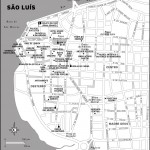
Photo © Michael Sommers.
Most people who visit Diamantina are lured by the splendid colonial architecture that has earned the 18th-century diamond mining town UNESCO World Heritage status. Yet amidst the elegant casas coloniais and ornate baroque churches lie the traces of a small but seminal moment in Brazilian Modernism.
It just so happens that Diamantina is the birthplace of “bossa nova” president Juscelino Kubitshek, whose humble childhood home, converted into a museum/shrine, is a popular site of pilgrimage for those who equate the “JK” years (1956-61) that preceded Brazil’s 21-year-long military dictatorship with a Brazilian version of Camelot.
By the time Kubitschek was sworn in as president, he and Niemeyer had a friendship and working relationship that dated to the early 1940s and the beginning of their respective careers.JK’s most lasting legacy, of course, was the fantastically futuristic capital he built in under 4 years in the middle of what was then nowhere; Brasília. For this pharaonic undertaking, he hired renowned Modernist architect Oscar Niemeyer – but not for the first time. By the time Kubitschek was sworn in as president, he and Niemeyer had a friendship and working relationship that dated to the early 1940s and the beginning of their respective careers.
In 1940, Kubitschek had just been elected mayor of Minas Gerais’ capital of Belo Horizonte. Founded in 1897, “BH” was one of Brazil’s first planned cities and was still very much in its early stages of growth. In keeping with his nickname of “prefeito furacão” (“the hurricane mayor”), Kubitschek invested heavily in Belo Horizonte’s urban development. Among his most visionary plans was to create an entirely new neighborhood dedicated to leisure ad recreation. For this purpose, he hired Niemeyer, a young disciple of Le Corbusier from Rio de Janeiro, to design an ensemble of buildings that would surround an artificial lake known as the Lagoa de Pampulha.
The resulting oeuvre included a church, dance hall, tennis/yacht club, and a casino (transformed into a museum following the prohibition of gambling halls). Known collectively as the Conjunto Arquitetônico de Pampulha, Niemeyer’s curvaceous concrete edifices shocked Belo Horizonte’s conservative and provincial elites. At the same time, they revolutionized Modernist architecture and cemented the working relationship between Kubitschek and Niemeyer.
As a result, in 1950, when Kubitschek was elected governor of Minas Gerais, one of the first things he did was to call upon Niemeyer to create some more Modernist magic – only this time in his hometown of Diamantina. Between 1950 and 1954, a quartet of Niemeyer’s clean-lined, concrete edifices were erected amidst Diamantina’s wild rocky landscapes and baroque treasures: the Diamantina Tênis Clube, the Hotel Tijuco, the university’s dentistry faculty, and the Escola Júlia Kubitschek (a public school named in honor of JK’s mother, who was an elementary school teacher).
Today only two of these buildings remain preserved and operational. Local schoolchildren still study in the airy, illuminated classrooms of the Escola Júlia Kubitschek. Meanwhile tourists continue to check into the spacious, minimalist, yet cozy (due to lots of natural wood fixtures) Hotel Tijuco, whose verandas offer stunning views of the city and surrounding Serra dos Cristais mountain range (rates are incredibly affordable).
Niemeyer’s Diamantina oeuvre is notably different from both his prior undertakings in Belo Horizonte and his future ones in Brasília, in which he projected Modernist microcosms onto tabula rasas. In Diamantina, he was faced with the question of how to integrate (or not) Modernist architecture with pre-existing historical buildings. At the time, the reigning theory in Brazil was that new constructions should do everything possible to distinguish themselves – and Niemeyer’s buildings in Diamantina certainly hew true to this credo.
Interestingly, at the same time that Niemeyer left his mark on Diamantina, the baroque city also made an indelible impression upon the Modernist master. One of Diamantina’s most famed and unusual landmarks is the Mercado Municipal (featured above). Built in 1835, the market anchors the lively central square of Praça Barão de Guaicui and boasts wooden arches, painted blue and red, which are impressive in their simplicity.
Indeed, they so impressed Niemeyer that when the architect was summoned by his friend Kubitschek to dream up a design for what was to become the Palácio da Alvorada, the official presidential residence in Brasília, he drew upon his memories of Diamantina’s marketplace for inspiration. As such, while it’s possible to find seeds of Brasília in Diamantina, it’s also possible to encounter vestiges of the colonial diamond mining town in the nation’s futuristic capital.